Your Time has Finished
Loading...
BMAT 2011-S2
Your Score: %
Average Score of All Users:
You performed better than of students
Section Breakdown
| Your Score | Average of all Users | Percentile | |
|---|---|---|---|
| BMAT 2011 S2 |
BMAT 2011 S2
Your score:
Average score:
You performed better than of students
This section is Section 2 of 3.
Speed as well as accuracy is important in this section. Work quickly, or you might not finish the paper. There are no penalties for incorrect responses, only marks for correct answers, so you should attempt all 27 questions. Each question is worth one mark.
You must complete the answers within the time limit. Calculators are NOT permitted.
Good Luck!
Note – if press “End Exam” you can access full worked solutions for all past paper questions
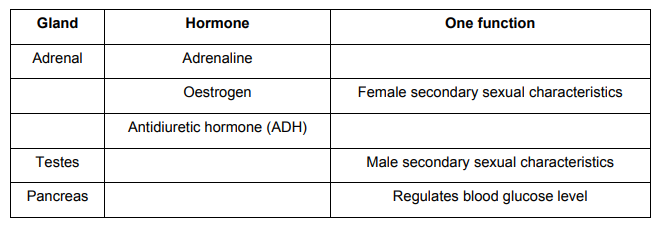
Explanation
The correct answer is F.
Carbohydrase does not fit into anything. Adrenal glands release adrenaline which can increase heartbeat rate. Ovaries produce oestrogen, leading to female secondary characteristics. Testes produce testosterone which lead to male secondary characteristics. Pituitary glands produce Antidiuretic hormone (ADH), which regulates water level in the blood. Pancreas produces insulin, which regulates blood glucose level. All these glands, hormones and functions are related to the hormonal homeostatic response.
Carbohydrase is an enzyme, which is involved in digestion, and so does not fit into homeostatic processes.
A metal, X, is in group III of the periodic table. A non-metal, Y, is in group VI of the periodic table. They react together to form a compound.
Explanation
The correct answer is B.
X – in group 3 – has 3 electrons in its outermost shell. Y – in group 6 – has 6 electrons in its outermost shell. The metal X needs to remove all of its 3 electrons, and the non-metal Y needs to gain only 2 electrons. Hence, X can supply 2 electrons to each of the 3 Y atoms.
This is as, 3 X 2 = 6 (as the lowest common multiple between 2 and 3 is found).
The supply of 6 electrons, due to 2 X atoms, balances with the demand of 6 electrons, due to 3 Y atoms. (2 x 3 = 6, 3 x 2 = 6)
Two identical cars, P and Q, start at the same level. Car P moves at a constant speed of 10m/s up a hill to a height of 25m in a time of 20s. In the same time car Q moves at a constant speed of 20m/s up a hill to a height of 50m.


Explanation
The correct answer is C.
Calculate GPE and KE of both cars and compare
GPE
P: mgh = 25mg
Q: mgh = 50mg
Hence, Q has 2xGPE as P KE
P: 1⁄2mv2 = 1⁄2 x m x (10)2 = 50m
Q: 1⁄2mv2 = 1⁄2 x m x (20)2 = 200m
Hence, Q has 4xKE as P
Simplify:

Explanation
The correct answer is C.
Firstly, deal with the powers. Powers inside brackets are always multiplied by the power outside the bracket. Hence,
(3x-⅓)³=27x-¹
27x-¹x 3x = 81
The following statements relate to typical nuclear division in human cells:
1 mitosis results in variation within the species
2 meiosis results in the production of genetically identical cells
3 mitosis results in the production of diploid cells
4 meiosis results in the production of haploid cells
5 mitosis results in the production of two daughter cells
Explanation
The correct answer is F.
Statements 3,4 and 5 are fully correct – they are facts to be learned for cell division – Mitosis produces diploid cells (with a full set of chromosomes), whereas meiosis produces haploid cells (with half the number of a full set of chromosomes), and mitosis produces 2 daughter cells. Statements 1 and 2 are incorrect, as they are mixed up. The correction is: Mitosis results in the production of genetically identical cells, and meiosis results in variation within the species (due to genetic recombination and crossing over).
When molecules collide, for a reaction to take place, two conditions must be met. Firstly, they must have sufficient energy to react and secondly, they must have the right orientation. This means that the ends of the molecules that are going to react must be in contact with each other.
Raising the temperature speeds up a chemical reaction.
1 More collisions take place.
2 The average collision has more energy.
3 The orientation of the molecules is more favourable.
Explanation
The correct answer is D.
At higher temperatures, particles have more kinetic energy, so move faster, so are more likely to collide with each other. Therefore the frequency of collisions between particles increases, so statement 1 is correct.
As the average amount of kinetic energy carried by a given particle increases, a given collision has more energy, so 2 is also correct.
Particles move randomly, so the orientation in which they collide is also random. Therefore increasing the temperature, which increases the random motion of the particles, will not make their orientation more favourable (but it may make it more likely that they are in a favourable orientation needed for a successful collision because they change their orientation more frequently at a higher temperature). So statement 3 is not correct.
Therefore only statements 1 and 2 are correct.
Which one of the following statements about nuclear physics is true?
Explanation
The correct answer is E.
E is correct, as the emission of a beta particle is due to a neutron changing into a proton (+ an electron), hence no particles are lost from the nucleus, and the mass number remains the same. All other are incorrect here are their correct versions:
A – The process of emission of a gamma ray from a nucleus is called gamma radiation
B – The half-life = the time taken for half of the nuclei to decay
C – Neutrons = mass number – atomic number
D – Nuclear fission occurs in power stations
F – In alpha emission, 2 neutrons and 2 protons (helium nucleus) are released from the nucleus
If you look at a clock and the time is 9.45, what is the angle between the hour and the minute hands?
Explanation
The correct answer is D.
When it is 9:00pm, the angle between the hour and minute hands is 90 degrees. There are 3 equal divisions between 9 and 12.
Hence, the angle between each hour is 90/3 = 30. However, the hour hand is 3⁄4 of the way between 9 and 10, whereas the minute hand is exactly at 9. As there is a 30 degree angle between 9 and 10, 3⁄4 x 30 = 22.5
 aria
Medicmind Tutor
aria
Medicmind Tutor
Wed, 20 Sep 2023 16:14:12
i just thought that it must be less than 30 and closest was 22.5 so..
Here are five statements about natural selection:
1 Individuals within a species show variation.
2 Individuals within a species compete with each other for, among other things, resources.
3 Individuals with advantageous adaptations are more likely to survive to adulthood.
4 Only individuals with advantageous adaptations will be able to breed.
5 Alleles for advantageous adaptations are more likely to be inherited.
Explanation
The correct answer is C.
Statements 1,2,3 and 5 are correct. Statement 4 is incorrect – it is too definitive; the use of only cannot validate that statement, as individuals with advantageous adaptations are more likely to survive adulthood (as given with Statement 3), and so are more likely to breed due to their survival. However, there are other factors i.e. competition in breeding, hence survival advantages are not definitive of breeding. Statement 1 is correct – individuals within a species show variation due to genetic recombination and crossing over at meiosis, the random process of fertilisation and mating with individuals that have different alleles to one’s own. Statement 2 is correct – individuals within a species compete with each other for resources etc. due to the instinct of survival. Statement 5 is correct – Alleles for advantageous adaptations are more likely to be inherited, as those individuals survive, and so are more likely to breed, hence passing their adaptations to their offspring.
Cyclohexene, C₆H10, can be represented as:
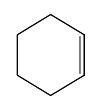
Use this information to calculate the relative molecular mass of the hydrocarbon shown below:

[Ar values: H = 1; C = 12]
Explanation
The correct answer is D.
The hydrocarbon, is essentially 2 cyclohexene molecules, with a loss of a C=C double bond, replace with a singular C-C single bond. Hence, the number of C atoms = 2 X C = 12; as each carbon joined to 2 other carbons – 12 – 2 = 10. Hence, 10 carbons.
First, each 10 carbons have 2 Hydrogen atoms each: 10 X 2 = 20. However, the carbons joined to 3 carbons only have 1 H atom each – which occurs twice in the structure. Hence, subtract 2 H atoms overall: 20 – 2 = 18
Mr = 10C + 18H C10H18 10 (12) + 18(1) = 120 + 18 = 138
Consider this circuit.
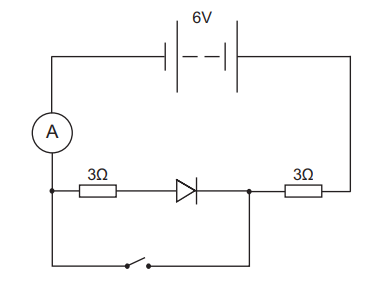
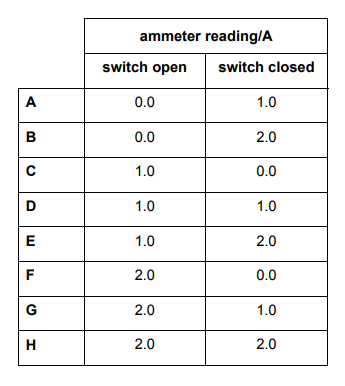
Explanation
The correct answer is B.
The diode only allows movement in one direction, which is from the negative to the positive terminal. A short circuit does not occur here when the switch is closed, as the diode forces the current to travel in its path. Hence, the current is the same regardless of the closure or opening of the switch. R = 3 + 3 = 6. V=IR, I=V/R hence, I = 6/6 =1.0A.
w, x, y and z are integers such that w < x², x > y², y² < z² and x > z.
Explanation
The correct answer is D.
We do not have enough information on w, hence we can ignore it. As x²>y²,it can be inferred that x>y. However, we must check if this is the only true inequality, with the next 2 inequalities:y² <z²– we do not know whether x is greater/less than z. Inequality 3; x>z, hence it can be deduced that x² >z²
Hence, x>y>z. As the only statement of x>y exists, which is correct, it is selected.
The table below shows information relating to gas exchange in an active muscle when blood first enters that muscle.
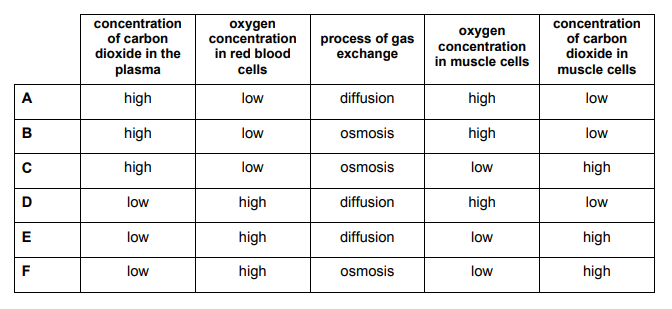
Explanation
The correct answer is E.
When blood enters an active muscle first, it is oxygen rich (high oxygen concentration), as it has been supplied with oxygen via alveolar gaseous exchange in the lungs. There, the carbon dioxide diffuses out of the lungs, hence the concentration of carbon dioxide is very low in this oxygenated blood. Gaseous exchange between capillaries and cells occurs via diffusion.
Oxygen diffuses across the cell membrane of the cells down a concentration gradient from the blood. Carbon dioxide diffuses down a concentration gradient, from the cells to the blood. Oxygen concentration in active muscles is very low, as oxygen is being supplied for respiration, to generate energy in contraction. Carbon dioxide concentration increases, as the respiring muscle cells release carbon dioxide as a by product.
Which of the following (A-E) correctly identifies all of the compounds from the list below that contain covalent bonds in their structure?
CO₂ (g) Ca(OH)₂ (s) H₂SO₄ (l) MgCO₃ (s) NaCl (s) Na₂O (s) Na₃PO₄ (s) SO₂ (g) SiO₂ (g)
Explanation
The correct answer is C.
Reading this question, you may be inclined to discard all ionic structures. However, the question asks for the compounds which contain covalent bonds. Hence, ionic compounds which involve a metal bonded to a non metal compound contains covalent bonds. This is as, the non metal compound itself, is formed from 2 or more non-metals, which are held together by covalent bonds.
Ionic compounds which have covalent bonds:a
Ca(OH)2 covalent bond exists between O-H
MgCO3 3 covalent bonds between 3 C-O
Na3PO4 4 covalent bonds between 4 P-O
(This question is not to be confused with the property of covalent character – that property exists due to polarisation of electron density in ionic compounds due to the relative sizes and charges of the metal and non-metal ions. Ionic bonds with covalent character may or may not have covalent bonds.)
A bullet of mass 50g is fired from a rifle with a velocity of 300m/s. It hits a bank of earth and after travelling 60cm into the bank comes to rest.
Explanation
The correct answer is B.
Initial velocity (u) = 300ms-¹,
final velocity (v) = 0
mass = 0.05kg
Deceleration = 0.6m. As, s= – u ²/2a (from v² = u² + 2as 0 = u² + 2as – u² = 2as )
-a = 1⁄2 x (300)²/(2×0.6) = -75000
F=ma
F = (0.05)(-75000) = 3750 N = 3.75 x 10³N
The graphs of the following equations are drawn:
1 y = 3x – 2
2 y = x²
3 y = 1 – x²
4 y = x + 6
Explanation
The correct answer is E.
Algebraically, for graphs not to intersect, there is no real solution. To demonstrate this, you can try to solve for x for answers A-E.
A) 1 and 2: 3x-2=x²
x²-3x+2=0
(x-1)(x-2)=0 Hence, equations 1 and 2 intersect at x=1, x=2
B) 1 and 3: 3x-2=1- x²
x²+3x-3=0
This equation cannot be solved by the sum and product method, hence we use completing the square.
(x+3/2)²– 3=0 (Divide 3 (the coefficient of x) by 2, and arrange in form (x+b/2)²+ c=0, where ax²+bx+c=0))
(x+3/2)²– 9/4 – 3 = 0 (Square the divided x coefficient, and subtract it from the entire equation ( (3/2)² = 9/4 ; (b/2)² = b2/4 →(x+b/2)²+ c – b²/4 = 0
(x+3/2)²– 21/4 = 0 → (x+3/2)²= 21/4 x+3/2= ±√21/2 (Take the square root of the equation. Remember that the number on the right hand side is ±)
Rearrange: x=-3/2±√21/2 → Hence, equations 1 and 3 intersect at x=-3/2+√21/2, x=-3/2-√21/2
C) 2 and 3:x²=1-x²
2x²=1 → x² =1/2 → x=±1/√2 Hence, equations 2 and 3 intersect at x=1/√2, x=-1/√2
D) 2 and 4: x²=x+6
x²-x-6=0
(x-3)(x+2)=0 Hence, equations 2 and 4 intersect at x=3, x=2
E) 3 and 4: 1 – x² =x+6
x²+ x + 5=0
This equation cannot be solved by the sum and product method, hence we use completing the square.
(x+1/2)²+ 5=0
(x+1/2)²– 1/4+5=0
(x+1/2)²+ 19/4=0
(x+1/2)²= – 19/4
A square root of a negative number will give an imaginary number, not an integer. Hence, no real solution is observed. Hence, lines 3 and 4 do not intersect.
 aria
Medicmind Tutor
aria
Medicmind Tutor
Wed, 20 Sep 2023 16:23:36
such a time consuming question and i still got it wrong
The genetic condition represented by the shading is caused by the presence of at least one allele for the condition.
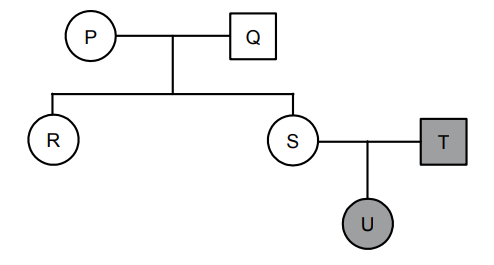
1 The condition is dominant.
2 The sperm from T carried the allele for the condition.
3 A mutation present in a egg of S.
Explanation
The correct answer is D.
Statement 1 is correct – the condition is dominant – as the question states that the genetic condition is caused by the presence of at least one allele. This eliminates recessive alleles, as they can only be expressed if there are more than 1 recessive alleles. Dominant alleles can be expressed if they are single or multiple as alleles. As the condition is dominant, it could be possible that the sperm from T (no genders are specified) carriers the allele, which may have been inherited by U through the random process of fertilisation. Statement 3 does not contradict with Statement 2, as it suggests that S is female (egg). A mutation can cause a change in the base sequence, resulting in changes within the allele. The previously non-functional allele, may now code for the condition, after the mutation.
Nitrogen Monoxide is prepared by reacting copper with nitric acid.
aCu + bHNO₃ → xCu (NO₃)₂ + yH₂O + 2NO
Explanation
The correct answer is E.
Using simultaneous equations:
We can see that, a=x ; (H) b=2y ; (N) b=2x+2 ; (O) 3b=6x+y+2
Comparing b = 2y with b = 2x +2 2x + 2 = 2y x + 1 = y
Substitute b=2y in O: 6y = 6x + y + 2 5y – 6x = 2
Substitute y = x + 1 in 5y – 6x = 2 5(x+1) – 6x = 2 5x + 5 – 6x = 2 hence x =3.
As x + 1 = y y = 4
b=2y ; hence, b = 8
a=x hence, a = 3.
Hence, 3Cu + 8HNO3 3Cu(NO3)2 + 4H2O + 2NO
Which graph correctly shows how the resistance (R) varies with applied voltage (V) for a resistor at constant temperature?
Explanation
The correct answer is A.
A resistor at constant temperature, does not alter in resistance, and so according to V=IR, V is proportional to R, and so the voltage also remains constant. If the temperature increases, the resistance increases, as heat causes resistor atoms to vibrate. This leads to more collisions between electrons and resistor atoms, and collisions cause the dissipation of energy of the electrons. Hence, the voltage would decrease in such a case.
The diagram shows three similar right-angled triangles.
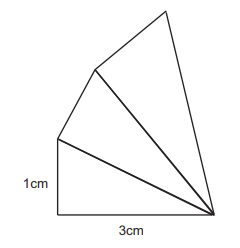
Explanation
The correct answer is B.
The area of the triangle given is 1⁄2bh = 1⁄2 x 3 x 1 = 3/2
As all 3 triangles are similar, their angles all have the same values. Assuming the top of the triangle is the largest, we can calculate their hypotenuses. Let’s call each triangle (beginning from the bottom) A, B and C respectively. The hypotenuse of the triangle A becomes the base of triangle B.
3² +1²=10 ; Base of B = √10. As similar triangles, the height of B must follow the ratio of height : base from A. 1:3 →Height B: √10. √10/3 is the scale factor, hence the height of B: 1 x √10/3 = √10/3
Hypotenuse of C:
(√10)² + (√10/3)²= 10 + 10/9 = 100/9 ; Base of C = 10/3. As similar triangles, the height of B must follow the ratio of height : base from A. 1:3 →Height C: 10/3
10/9 is the scale factor, hence the height of C: 1 x 10/9 = 10/9
Area of the largest triangle = 1⁄2 x 10/3 x 10/9 = 1⁄2 x 100/27 = 50/27
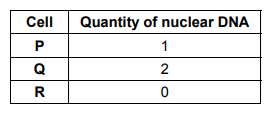

Explanation
The correct answer is D.
It may be hard to grasp what the question is asking, as ‘nuclear DNA’ is very vague here. It is referring to the chromosomal arms/double helix of the DNA. As an egg cell is haploid, it contains half the number of nuclear DNA relative to a normal body cell, hence its quantity is ‘1’, as DNA is in a single helical structure. In comparison, the quantity of nuclear DNA of a nerve cell is ‘2’, as it contains DNA as a double helix, with double the quantity of nuclear DNA relative to gametes. An enucleated egg cell, in which enucleated refers to a cell that has no nucleus, will have 0 nuclear DNA.
An ore of lead contains 70% of PbS.
Calculate the mass of lead that can be extracted from 478kg of the ore.
[Ar: Pb = 207; S = 32]
Explanation
The correct answer is D.
Firstly, calculate the amount of PbS in the ore:
0.7 X 478 = 334.6 kg.
Find the percentage of molar mass of Pb in PbS:
Ar(PbS) = 207 + 32 = 239
The percentage of Pb = 207/239
Amount of Pb extracted: 207/239 X 334.6 = 289.80 kg.
A ray of orange light travelling through air has a speed of 3.0 x 10⁸ m/s and a wavelength of 600nm. (1nm = 10-⁹ m)
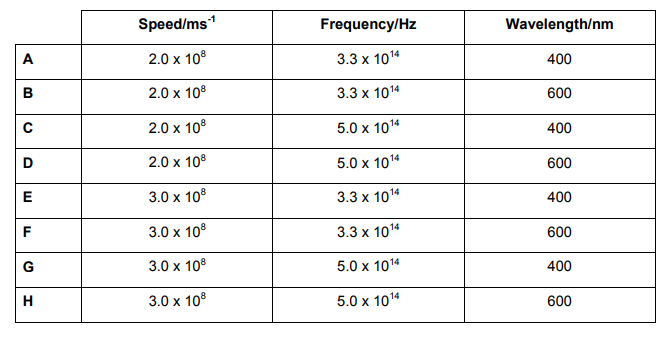
Explanation
The correct answer is C.
Frequency is invariant:
f = c/λ (3 x 10⁸) / (600 x 10-⁹) = 5 x 10¹⁴ Hz
(Although not given, in glass the speed of orange light: 2/3 x 3 x 10⁸ = 2 x 10⁸) λ = c/f 2 x 10⁸/5 x 1014 = 4 x 10-7 = 400nm
I have two six-sided dice, each with faces numbered from 1 to 6. One of the dice is fair, but the other is not – it will land on numbers 1 to 5 with equal probability, but lands on 6 with a different probability.
When I roll the dice the probability that I get a total of 12 is 1/18.
Explanation
The correct answer is B.
To get a total of 12, both die can only display 6 (as 6+6=12). The probability on the unbiased die: 1/6.
As 1/18 = P(6,unbiased) x P(6,biased)
P(6, biased) = 1/18 / (1/6) = 1/3
Hence, P(1-5, biased) = 1-1/3 = 2/3
As 1-5 all have equal probabilities, (2/3)/5 = 2/15
To get a 2, only possibility is 1+1
P(1,unbiased) = 1/6, P(1,biased) = 2/15
Hence, 1/6 X 2/15 = 2/90 = 1/45
The graph below shows how one factor in the internal environment in a person changes, and is returned to a normal level.
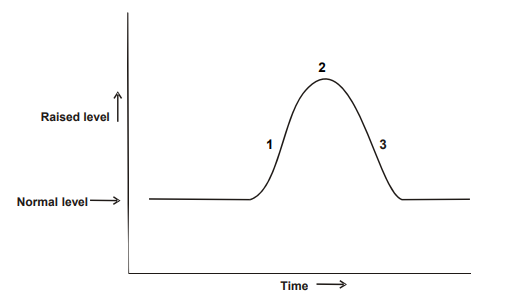
Explanation
The correct answer is D.
If the homeostatic system is less responsive, the time taken to respond doesn’t change; however, the frequency of response changes. In order to change the frequency, the raised level would have to be higher, hence 2 is raised. This is as, this would steepen the graph from both sides (1 and 3), and in order for a response to occur, a new higher threshold is set.
An impurity in petroleum is dimethylsulphide, CH₃SCH₃.
Explanation
The correct answer is E.
From previously knowledge, sulphur impurities in petroleum fuel always release SO2 to the atmosphere, when burnt. Hence, it can be D or E. The condition is, ‘an excess of air’, which indicates complete combustion. For complete combustion to occur, CO2 must be a product, as opposed to CO. This eliminates D, hence E is the correct answer.
At the front of a long column of soldiers is a man regularly hitting a drum 50 times a minute. The soldiers are told to place their left foot down on the ground when they hear the drum beat. The column is so long that the soldiers at the back put down their left feet at the same time as the soldiers in the front put down their right feet.
[Speed of sound in air is 330m/s]
Explanation
The correct answer is B.
Their right foot comes down between each beat. Each beat occurs after 60/50 seconds. The delay is half of the total beat, as it is between two beats, which is 60/100. Distance = Speed x Time = 330 x (60/100) = 198m
BMAT 2011 S2 Review Screen
Instructions
Below is a summary of your answers. You can review your questions in three (3) different ways.
The buttons in the lower right-hand corner correspond to these choices:
1. Review all of your questions and answers.
2. Review questions that are incomplete.
3. Review questions that are flagged for review. (Click the 'flag' icon to change the flag for review status.)
You may also click on a question number to link directly to its location in the exam.
BMAT 2011 S2 Section
Final Answer Review Screen
Instructions
This review section allows you to view the answers you made and see whether they were correct or not. Each question accessed from this screen has an 'Explain Answer' button in the top left hand side. By clicking on this you will obtain an explanation as to the correct answer.
At the bottom of this screen you can choose to 'Review All' answers, 'Review Incorrect' answers or 'Review Flagged' answers. Alternatively you can go to specific questions by opening up any of the sub-tests below.
BMAT 2011 S2 Section
TI-108
Let's get acquainted ?
What is your name?
Nice to meet you, {{name}}!
What is your preferred e-mail address?
Nice to meet you, {{name}}!
What is your preferred phone number?
What is your preferred phone number?
Just to check, what are you interested in?
When should we call you?
What time works best for you? (UK Time)
How many hours of 1-1 tutoring are you looking for?
My WhatsApp number is...
For our safeguarding policy, please confirm...
For our safeguarding policy, please confirm...
Which online course are you interested in?
What is your query?
SubmitYou can apply for a bursary by clicking this link
https://www.medicmind.co.uk/medic-mind-foundation/Sure, what is your query?
SubmitLoading...
Thank you for your response.
We will aim to get back to you within 12-24 hours.
Lock in a 2 Hour 1-1 Tutoring Lesson Now
If you're ready and keen to get started click the button below to book your first 2 hour 1-1 tutoring lesson with us. Connect with a tutor from a university of your choice in minutes. (Use FAST5 to get 5% Off!)
Buy Now for £70